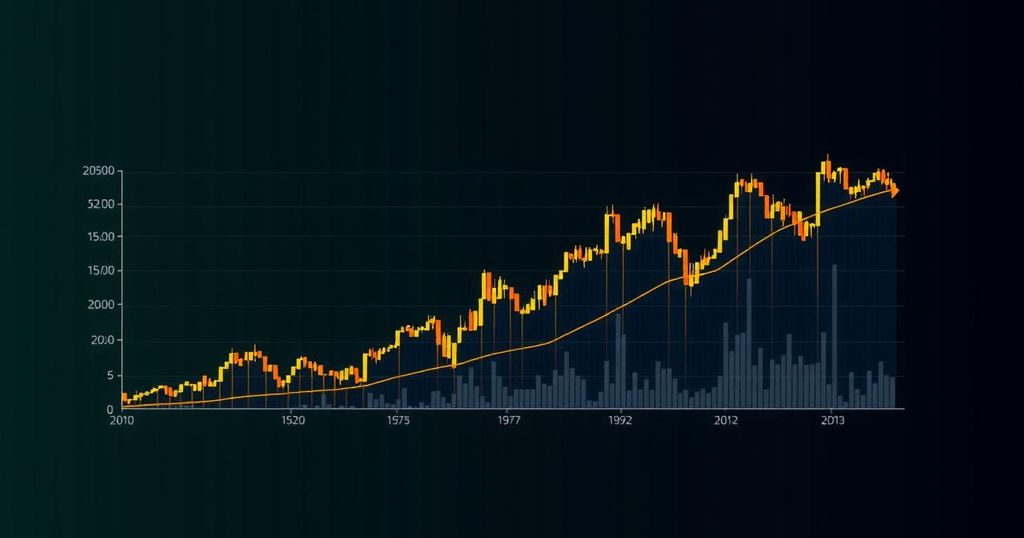Anticipated Bitcoin Price Movements: A Historical Perspective
Summary
Current analyses indicate that Bitcoin’s price may benefit from anticipated US Federal Reserve rate cuts, with potential for consistent gains throughout the fourth quarter of this year. Historical trends suggest a rally following the US elections in November, and a peak price could be observed by year-end 2025. These insights are backed by previous Bitcoin performance patterns and significant market events, despite economic uncertainties.
The analysis of Bitcoin price movements suggests several key expectations based on historical trends. Firstly, the anticipated rate cuts by the US Federal Reserve, scheduled for their next meeting on September 17 and 18, are likely to present a bullish opportunity for Bitcoin. Historical patterns indicate that such rate cuts significantly expand money supply, providing investors with additional capital for riskier assets such as Bitcoin. The last significant rate cut in March 2020 led to a substantial rally, culminating in Bitcoin reaching an all-time high of approximately $69,000 in November 2021, rising from around $7,000 at the time of the rate cut. Looking ahead to the fourth quarter of this year, Bitcoin may experience three consecutive positive months. Data from Coinglass illustrates that in previous halving years, Bitcoin exhibited positive monthly performance in October, November, and December. Given that a halving event occurred this year, many investors are optimistic that Bitcoin will conclude the year on a positive note. Post US elections in November, there exists an expectation of a price rally, echoing patterns observed following the last two presidential elections in 2016 and 2020. As market uncertainties reduce post-election, increased capital deployment into assets like Bitcoin is likely. Expert predictions vary regarding potential price increases, with Bernstein analysts projecting a rise to $90,000 should Donald Trump win, while others, including Steven Lubka of Swan Bitcoin, advocate that Bitcoin’s performance is tied more closely to monetary dynamics than electoral outcomes. Looking further into the future, Bitcoin’s price peak is predicted for year-end 2025, coinciding with its four-year halving cycle, which typically initiates a bullish market. Historical analysis reveals peaks occurring approximately 16 to 18 months after halving events. Notably, Bitcoin prices hit peaks 518 days post-halving in 2016 and 546 days in 2020, suggesting a possible peak in September or October 2025. Additionally, theoretical frameworks, such as the Mars-Vesta Cycle theory, render a similar peak prediction for October 2025, with expectations of prices ascending to $100,000 or more. Moreover, a recent identification of a Golden Cross on Bitcoin’s chart may herald a significant price rally, as past occurrences of this bullish signal have often preceded substantial price increases. However, it is crucial to remain vigilant of potential macroeconomic challenges posed by the current state of the US economy, which could hinder any expected price surges despite these promising historical trends. In conclusion, Bitcoin’s trajectory in the near future appears optimistic, particularly with the influence of historical trends, prospective rate cuts, post-election capital deployment, and the typical cyclical price peaks associated with halving events. However, the economic landscape remains a noteworthy factor that could impact potential growth.
Bitcoin has consistently been analyzed through the lens of historical trends to predict its future price movements. These trends, while not infallible, often demonstrate repetitive patterns that can provide insight into the cryptocurrency’s next moves. Notably, significant events such as Federal Reserve rate cuts, Bitcoin halving cycles, and external market factors (including election outcomes) play pivotal roles in shaping Bitcoin’s price trajectory. Investors and analysts leverage these historical data points to formulate educated predictions regarding Bitcoin’s performance, particularly in light of upcoming events such as the US elections and anticipated economic shifts.
In summary, Bitcoin stands at a potentially bullish juncture as several historical indicators suggest favorable price movements in the near future. The conjecture surrounding rate cuts, successful historical trends during the fourth quarter, potential price rallies following the US elections, and the cyclical nature of Bitcoin’s halving events all contribute to a hopeful outlook for the leading cryptocurrency as we approach the end of 2023 and into 2025. Nonetheless, the macroeconomic variables warrant careful consideration as they could influence Bitcoin’s performance significantly.
Original Source: coingape.com







Post Comment